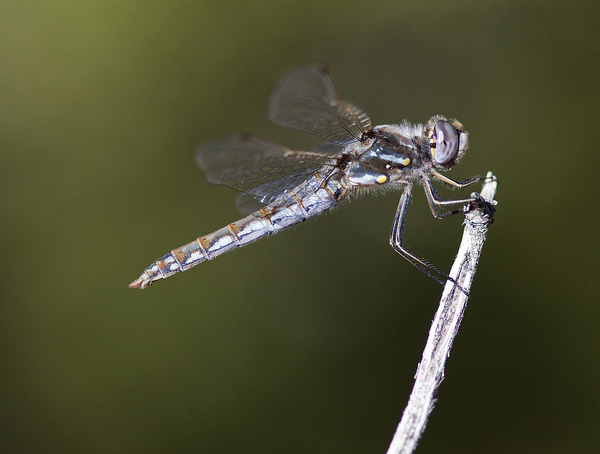
The photo above is a good example. The dragonfly is pretty bright, but the background is much darker. This strong contrast of brightness helps emphasize the edges, making the outline of the dragonfly appear much sharper.
This is actually how most sharpening algorithms work in post-processing software: by increasing the contrast of brightness between edges it makes those edges stand out more and appear sharper. That’s why oversharpened images have those ugly halos.
Of course, you won’t always be able to do this, but it’s something to keep in mind when you’re photographing more common or controllable subjects (like plants or common insects), where you’ll probably find a lot of different backgrounds available.
But, remember: the sharpest photo isn’t always the best photo. Your creative vision always comes first!
P.S. You may remember me talking about the dragonfly pictured above in a previous post.. Last year I tried to get a shot of a female Variegated Meadowhawk, but failed because of a poor background. I had better luck this year though 🙂
If you enjoyed this article, and would like to read more, please signup for free updates by email or RSS.
 About the Author: Steve Berardi is a naturalist, photographer, computer scientist, and founder of PhotoNaturalist. You can usually find him hiking in the beautiful mountains and deserts of Southern California.
About the Author: Steve Berardi is a naturalist, photographer, computer scientist, and founder of PhotoNaturalist. You can usually find him hiking in the beautiful mountains and deserts of Southern California.
Great article… really enjoyed it.
So much inspiration! If only I could find a dragonfly or a similar creature during the summer!
Thanks, Robert!
Evelyn – keep an eye out for dragonflies when you’re near water, that’s where they usually like to hang out 🙂
Wooooooooooww — Unreal!!!
Woooooww is too short a word to describe that great shot of the dragonfly above. I think that shot is absolutely fantastic. I took a lot of dragonfly shots last year when I bought my first little P & S camera. Because I was such a ‘beginner’ with poor eyesight, I failed to get any focused shots. But with patience & practise, I DID improve. I found that some dragonflies (or damselflies) land on blades of grass for ‘rests’ and one has a better chance of photographing them on their ‘rest’ breaks. Previously, I was trying to photograph them flying in the air.
Having bought a DSLR last Christmas, I’m hoping next summer’s dragonfly images will be even better (in Melbourne, Australia).
I’ve learnt quite a few good tips browsing through your archives today. Thankyou for such a great website.
Thanks for all the great hints n ideas….. Just thinking of buying the ebook… Great job!
Hi Steve: You have a great website and everyone who stops here benefits. One thing I have seen some photographers do is unintentionally not have the subject parallel to the camera sensor. One portion of their macro is in focus but not all. Looking at your insect above the head and tail are all about the same distance from the camera sensor. This adds to sharpness as well.
Thanks, Jan! You make a great point about making sure your camera’s sensor is parallel to the most important plane of your subject. That definitely helps ensure you maximize sharpness (which is great, as long as it doesn’t compromise a good background).